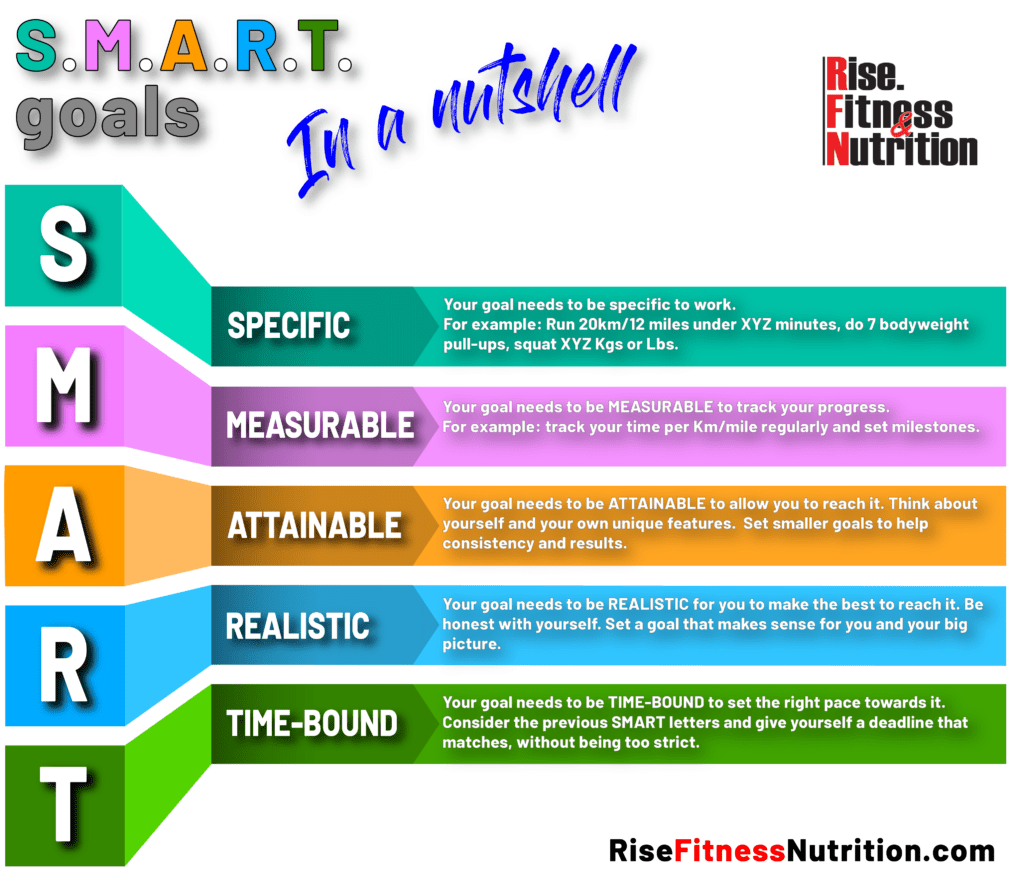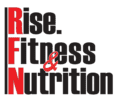Figure out your destination and work towards it.
Fitness goal setting 101, where to start to make good use of the time you spend working out and focusing on the right nutrition?
Having a goal to aim for!
Although this sounds pretty obvious, there are goals and goals. Let me explain you what I mean: when you want to take a vacation you choose the place, the budget, the date and everything else to make sure that you make the best of the time, you don’t simply walk into an airport and go randomly jumping on the first flight at hand.
Although in both cases you go on vacation, in one situation you go exactly where and how you wanted, in the other… you just go.
If this sounds like something you would never do, why this happens so often when it comes to fitness and nutrition?
How to set up a S.M.A.R.T. goal for your own fitness journey
What is a SMART goal? S.M.A.R.T. goal is an acronym that stands for:
- Specific
- Measurable
- Attainable
- Realistic
- Time-based
Motivation and SMART goals go hand in hand, so if you missed my previous article on motivation, you can find it right here.
Before reading on, let me ask you a question. If you think about your next goal when it comes to your fitness and nutrition, what comes to your mind?
If your answer is along the lines of I want to be healthy, be stronger, lose fat, feel better then this article is really for you. Even if these goals sound ok, they lack some essential components that would help you reach them at your best.
Let’s have a look at the elements to help you figure out your SMART goal.
S for SPECIFIC. A goal needs to be SPECIFIC to work
Whenever you have a fitness goal, it has to be precise to enable you to understand exactly what you’re aiming for.
Let me give you an example. I want to hip thrust three times my body weight. Now, this goal is very specific because it gives me a number, a value that I can track.
Then what else do I need to make the goal as specific as possible? Think about a potential deadline but don’t be too strict about it as there are factors that can directly influence its feasibility.
Let’s go back to my previous example:
If I start from zero and I have no experience in hip thrusting whatsoever, chances are I might not be able to hit the target of hip thrusting my body weight X3 in a year because it takes time and I need to build the muscles and the strength to get there safe and injury free. Nonetheless setting an ambitious goal will spark great growth and improvement.
If, on the other hand, you already have experience and are, already, on the way to X3 your bodyweight, then you have here a very specific goal with a value and a deadline time-wise. You’re not just saying that you want to “hip thrust more” as more like what? More compared to what? These are the types of questions you should ask yourself when setting a goal like, for example “I want to be healthier”
- Define healthier, what is healthier for you?
- Healthier compare to what or who?
- What are the markers that define your definition of healthy or unhealthy?
M for MEASURABLE. A goal needs to be MEASURABLE to track your progress
Back to my example: if you want to hip thrust three times your body weight, you want to make sure that your goal is trackable. That means that during the course of the year, you have to be aware that there are milestones to hit.
For example within, three months you need to be able to hip thrust a clear and reasonable amount of weight.
If your goal is to lose body fat, you should have the percentage of body fat that you have at the beginning of the year, and you should be able to set that in six months you want to be able to hit a reasonable and specific value.
If you want to run a marathon and you start from zero, you should have a clear measurable goal: a marathon is 40 kilometers. How do you track this? You want to be sure that every month you can run these amount of kilometers or these amount of hours.
Those are ways to make your goal specific and measurable. Remember, don’t think of a goal like “I want to be stronger” Stronger than what? Is it measurable? Always ask yourself these questions.
A for ATTAINABLE. A goal needs to be ATTAINABLE to allow you to reach it
Whenever you set your goals think about yourself and your own unique features. Let me give you again another example.
I would very like go and tackle Mount Everest. But if I sit down today and set as goal “tackle Mount Everest by December 31st” would it make any sense? Will I be able to do that with zero experience in such extreme conditions?
What I want to say is that yes, this is a specific and measurable goal but is it attainable? I am not sure, am I really going to be able to do that? Another example “squat four times my body weight”.
- It’s very specific.
- It is measurable because I can track my progress during the year
- Is it attainable? Well, probably not for me at this point in time.
When you plan your fat loss goal be sure to have it in a way that is specific, measurable, attainable and…
R for REALISTIC. A goal needs to be REALISTIC for you to make the best to reach it
Here you have to be honest with yourself because you know, more than anyone else what you can actually do and what you are capable of.
Back to “climb Mt. Everest” this is a very specific, measurable, attainable but realistic? Is going to happen? I don’t think so. Why? Well, because there are a lot of hurdles to overcome to do that. This goal has the previous features in check but is unrealistic.
To reach within 3 months 4% body fat percentage is it a realistic goal? Probably not unless you’re a professional bodybuilder with a precise strategy and a very strong will power. If you have other things to do such as having a regular life, job, family or kids.
Ask yourself is it realistic? If it is, you’re one step closer to defining your goal.
Be honest with yourself when you set your goals. Ambition is a great force but over estimating can drive quite the dissatisfaction and demotivation
T for TIME-BOUND. A goal needs to be TIME-BOUND to set the right pace towards it
We already talked about giving yourself a deadline but I also mentioned that the deadline should be a little flexible in these terms.
If you’re starting from zero and you want to deadlift three times your body weight within six months, that might be a little bit complicated. You know yourself, so you might consider to extend your deadline, also, there’s no rule that tells you that the deadline should be within the year.
There are things you can achieve in a longer course. So the fact that in January you are setting the goals for the next year, it is a great point to start from but keep in mind that sometimes those goals can go beyond the year and ultimately, don’t forget that life throws curveballs all the time.
Even if your goal’s deadline is within the year, you might not necessarily be able to hit that, and that wouldn’t be necessarily negative. If you worked hard to reach it, before feeling demotivated if you didn’t 100% make it, take a look at the progress you have made all the way here for example.
You know yourself.
You know how attainable your goal is.
You know how realistic your goal is.
Considering the previous SMART letters give yourself a deadline that makes sense, no need to be too strict. It would make the goal barely attainable or barely realistic, and then increase the risk of anxiety when the deadline comes.
Fitness goal setting 101, where to start? Well now you have good basis to move forward, let me know how it goes!



Pingback: Do you need really a gym to workout? - Rise. Fitness & Nutrition
Pingback: Rise. Fitness & Nutrition - Do you need cardio for fat loss?
Pingback: 4 pillars of your health and fitness - Rise. Fitness & Nutrition
Pingback: Build consistency to reach any goal in your life - Rise. Fitness & Nutrition